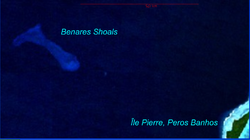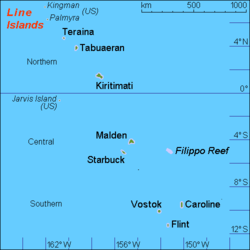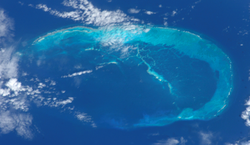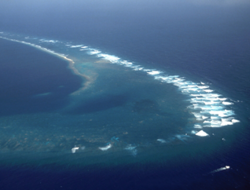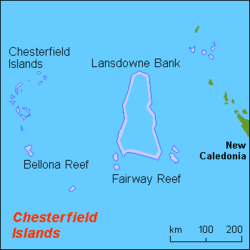
This is a list of notable reefs.
YouTube Encyclopedic
-
1/5Views:3 566 09777 46259 9509 866891
-
Exploring the Coral Reef: Learn about Oceans for Kids - FreeSchool
-
Coral Reefs for Kids | Learn about the 3 types of coral reefs Fringe, Barrier and Atoll
-
Types of Coral Reefs - Fringing/Shore Reef, Barrier Reef & Atoll Reef
-
Coral reefs | Ecosystems
-
Which Safe Sunscreen to Choose that Won't Hurt the Coral Reefs
Transcription
You're watching FreeSchool! From above, the ocean looks empty. Like a desert made of water, it seems barren ... uninhabited. ...But that's just on the surface. Come below the waves with me as we explore the riot of color and life that exists on the coral reefs. Coral reefs are only found in shallow, tropical seas. They may look like colorful rocks, or even plants, but coral is really an animal. Coral is built by polyps. Polyps are very small creatures that are related to jellyfish. Unlike the jellyfish, which propel themselves around the water, coral are stationary. They grow together in a colony called a coral head. A small piece of coral may be made of hundreds of polyps. A bigger one may have thousands! Hard corals create the reef by secreting calcium carbonate - or limestone, a type of rock, which gradually builds up into a solid structure. Coral grows slowly, only a few centimeters a year. It can take hundreds of years to form large pieces, like this. Of course, not all coral is hard, some types are soft. They may look like fans, bushes, or feathers, but once again it is really a colony of tiny animals living together. When many corals grow close together, it's called a reef. Reefs provide very important habitat for fish and other sea creatures. Coral provides shelter for little fish - a place to hide. That many small fish in one place attracts big fish, which in turn attracts big predators like sharks. This nurse shark is unusually active for the daytime. Usually a nurse shark will hide under ledges or in crevices of the reef, and come out at night to eat dormant fish that are hiding in the coral. Nurse sharks are slow-moving bottom-dwellers, and, for the most part, harmless to humans although they can grow up to 14 feet, more than 4 meters, in length. Their strong jaws allow them to crush shellfish and even coral, if need be, but they prefer to eat shrimp, fish, and squid. The reef also provides a place for algae and sponges to grow. This provides food for a variety of creatures: for example, the sea turtle. The Hawksbill Sea turtle, like most other kinds of sea turtles, is endangered. Hunted for their meat and for their shells, trapped in commercial fishing nets to drown, and sickened by pollution, their populations are declining. These turtles rely on the food that grows on the coral reef - and the reef, in turn, relies on the turtles. It's a partnership that benefits both creatures. The turtles get a reliable source of food. The reef system gets a less obvious advantage. Without the turtles coming to eat the algae and sponges, they would overgrow the reef - preventing the coral from growing and expanding. With lowered turtle populations in oceans worldwide, the health of coral reef systems will suffer. It is important for people to do our best to protect these peaceful reptiles, not just for their sake, but for the health of the entire coral ecosystem. Turtles and coral aren't the only partners you can find on the reef! Sea anemones are another animal that seems more like a plant. A relative of both coral polyps and jellyfish, anemones have their own partner to help make life easier...clownfish. Although it may not look like it, Anemones are predators. They have stinging cells in their tentacles that allows them to paralyze their prey - usually small fish, or shrimp - and then move them towards their mouth. Clownfish escape the anemone's sting by covering themselves in a protective layer of mucus! By hiding inside the anemone, clownfish are protected from predators that don't want to be hurt by the anemone. But what does the anemone get out of this, you may ask? Well, the little clownfish can chase away butterfly fish that would eat the anemone, and they can also clean the anemone of parasites and bits of food that the anemone has no way of cleaning itself. There's one more unusual pairing we're going to talk about today. Can you guess what parrotfish and beaches have to do with each other? Parrotfish are a distinctive family of fish species with a tough, bony beak so strong that they can bite through rock and coral! They do this so that they can eat the coral polyps and algae inside. The coral is ground up and all of the edible parts are digested until only the limestone remains. Then the parrotfish has to get rid of all of the crushed limestone - and there's only one way to do that. The parrotfish will excrete - or poop out - the limestone, which has been crushed into a fine sand. In this way a single parrotfish can produce 200lb or 90 kilos of sand every year. You heard that right. The next time you bury your toes in soft white sand at the beach, just remember: you're making castles with fish poop. Coral reefs are sometimes called the 'rainforests of the sea.' Though they cover only a tiny area of the ocean, they provide a habitat for a quarter of ocean animals. Unfortunately, the coral reef ecosystem is a fragile one. The delicate balance between the coral, algae, fish, and animals that live there is easily disrupted. Overfishing by humans, ocean pollution, and warming temperatures have all put the world's coral reefs are at risk. Right now, more than half of the world's reef systems are in danger of destruction, and if nothing changes, then within 15 years nearly all the coral in the world will be in danger of dying and disappearing. Fortunately, there are some simple things you can do to help protect the coral reefs. Be careful not to waste water, or pour chemicals down your drain, since eventually the water you use will reach the ocean and can increase pollution. Pick up trash that you see on the ground, and recycle what you can, so that garbage won't find its way into the water. Most importantly, make sure people know that you want to protect the coral reefs, so that when we make decisions about how to take care of our world, we will make choices that will protect the reefs. I hope you learned something new exploring the reef with me today! Goodbye till next time!
Reefs
See also
- Fringing reef
- Recreational dive sites
- Recreational diving
- Southeast Asian coral reefs
- The Structure and Distribution of Coral Reefs
References
- ^ Vidal, John (April 23, 2016). "Huge coral reef discovered at Amazon river mouth". The Guardian. Retrieved April 23, 2016.
- ^ "Definition of GREAT BARRIER REEF".
- ^ Edison Lobão; Fernando César de Moreira Mesquita (11 June 1991), Decreto nº 11.902 de 11 de Junho de 1991 (PDF) (in Portuguese), State of Maranhão, retrieved 2016-08-03




